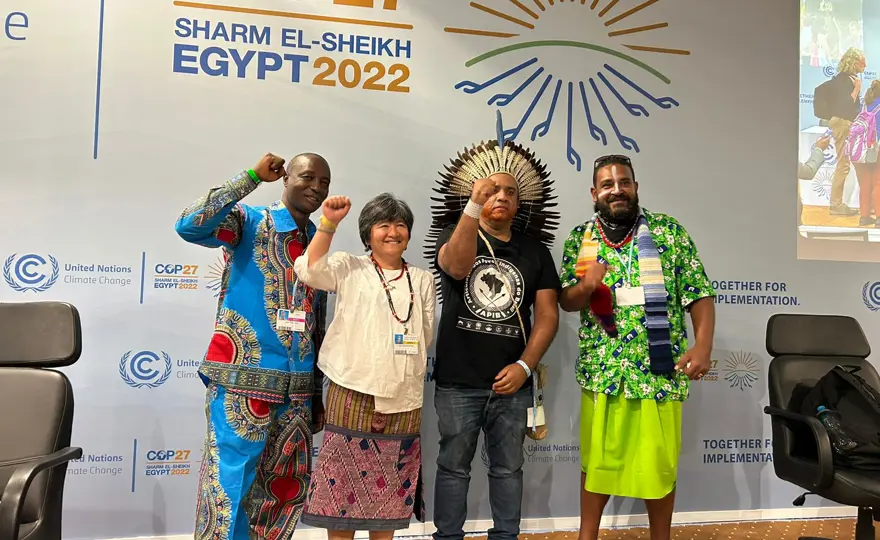ClientEarth Communications
16th December 2022


Throughout conversations about the global protection and restoration of nature, and the challenges that face us in doing it, reference is increasingly being made to Indigenous Peoples and Local Communities. This was especially true at COP15, where world leaders gathered to agree on how to protect and live in harmony with nature for the next ten years and beyond.
We spoke to our Head of Africa and South America work, Brian Rohan, Ioannis Agapakis - one of our wildlife lawyers, and some of our community partners from forest regions around the world, about how vital it is that Indigenous People are centred in the challenge of protecting and conserving nature, and why recognising the rights of these communities must be a priority.
The law plays a major role in nature conservation, because when a law or legal agreement is respected, it can contribute to the protection of the forest.
Elvis MVE - Brainforest, Head of the Norad project for sustainable management of community forests
‘Forests are a source of food, medicine and culture for communities; an environment that encompasses the entire life of communities; any loss of forest is a loss of identity, hence the importance of protecting it.’ - Lena Ilama, agent at the Ministry of Water and Forests in Gabon, former director of Community Forestry Department within the Directorate-General of Forests
‘IPLCs, almost 2 billion people, have the closest and most direct relationship with nature. Their primary livelihoods are directly dependent on biodiversity. Plain and simple, this direct dependence, combined with deep cultural and spiritual connection to ecosystems, makes IPLCs the best situated and most motivated stewards of the planet’s biodiversity. More than any of us, IPLCs understand the ruin that comes with extinction and ecosystem destruction.’ - Brian Rohan
‘IPLCs require recognition of their land rights. Their free, prior and informed consent is required for any intervention on their territories, and the climate funds – the biodiversity funds that the international community is mobilising – must include direct funding to the Indigenous Communities themselves, not to governments and companies pretending to be brokers and middlemen.’ - Brian Rohan
‘Forests are increasingly vulnerable; loggers are carrying out activities that affect the livelihoods of the communities that live in them, that depend on them. Forests are their means of survival; as much as communities are affected, forests are vulnerable.’ - Jenny Mboumba Madouta - Brainforest, Deputy Head of the Norad project
‘Conservation used to be practised in a traditional way, in that people naturally protected species that risked going extinct.’ - Lena Ilama, agent at the Ministry of Water and Forests in Gabon, former director of Community Forestry Department within the Directorate-General of Forests
‘There is a strong push to value biodiversity, somehow in the way that carbon now has a market value. However, biodiversity is far more complex than the fungible carbon atom. We need to be sure that all policies and instruments adopted in the Global Biodiversity Framework (GBF) – the plan to be agreed at COP15 and which will guide countries to protect biodiversity for the next ten years – strengthen IPLC stewardship opportunities and promote rapid net biodiversity gains. What we don’t want are mechanisms that create tradable biodiversity allotments that undermine the vital integrity of all ecosystems everywhere.’ - Brian Rohan
'We need to ensure that the conservation of biological diversity taking place inside indigenous lands and territories is being properly acknowledged, in line with their internationally recognised rights. IPLCs in particular, and the rest of civil society, play a key role in the conservation and sustainable use of biodiversity. The Framework being worked on at COP15 should therefore make space for their active and effective participation at all stages and levels of governance, from revising National Biodiversity Strategies and Action Plans, to delivering action on the ground and monitoring progress.' - Ioannis Agapakis
'If not addressed head-on and in a positive manner, the Global Biodiversity Framework risks marginalising the planet’s best stewards while creating a system that fails to meet its biodiversity objectives.
This past Sunday evening, I had the honor of participating in a discussion about Indigenous Peoples’ rights here at COP15 in Montreal, organised by the activist network If Not Us Then Who. Indigenous leaders from across the globe came together, sending a united message about their key demands for the Framework, and discussing important ways in which they can protect their homes and cultures.
A lot has been said about the global commitment to protect 30% of the planet’s land mass by 2030. This is an ambitious target, but must be implemented in a way consistent with IPLC land rights and decision-making processes in order to succeed. More than that, Indigenous leaders pointed out that in many countries with large Indigenous Peoples populations currently have much more than 30% of their land masses as intact forests. For this reason, through the entire Amazon basin, Indigenous activists are calling not for 30% of land mass to be protected by 2030, but for 80%.
This underscores the genuine urgency of the problem of deforestation, and also the large areas that still can be preserved if we act now. Facing political marginalisation, threats and worse, Indigenous Peoples nonetheless have made their voices heard loudly and clearly in Montreal. Country delegates: are you listening?’ - Brian Rohan